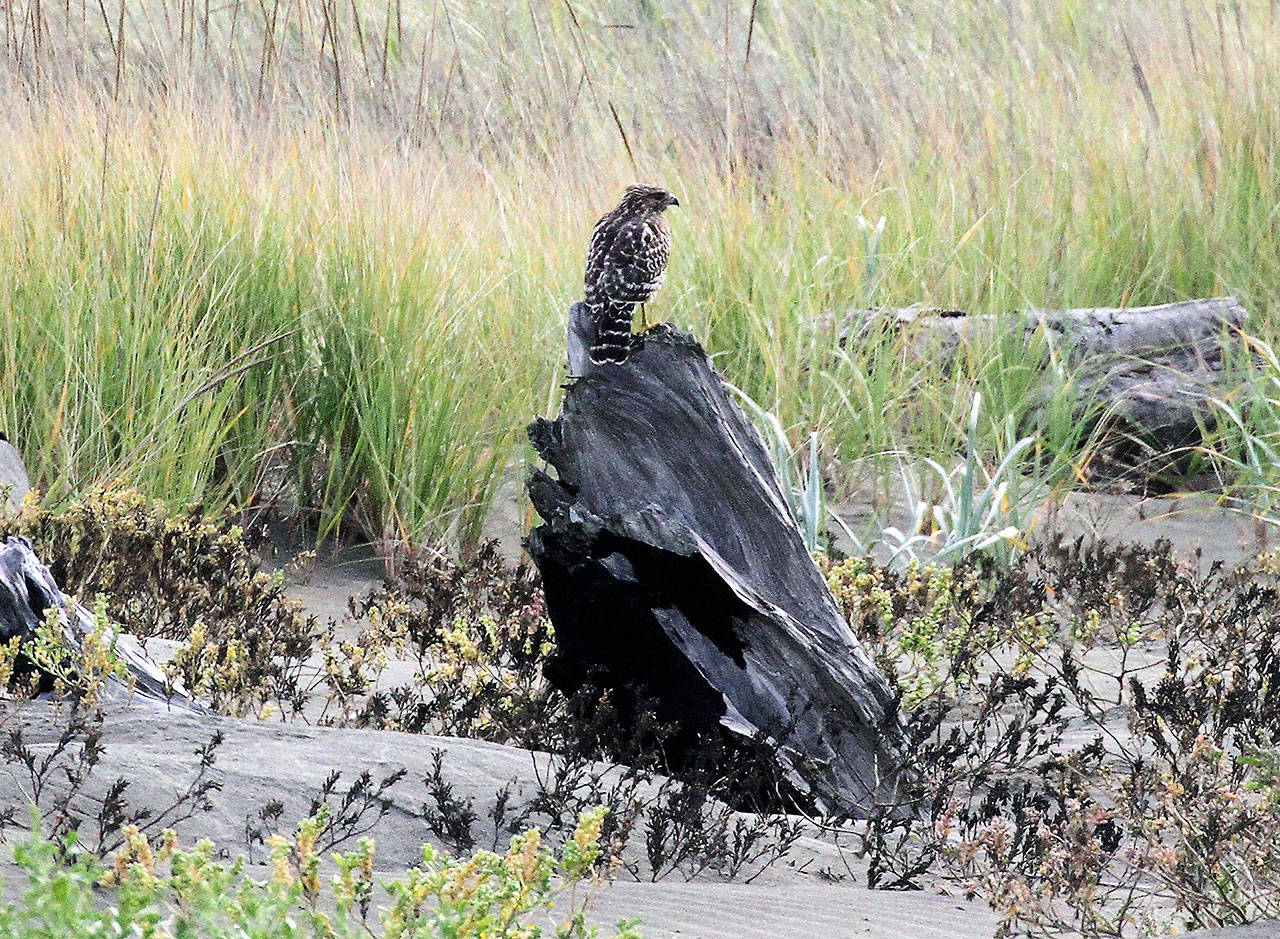By Dianna Moore
Grays Harbor Audubon
This bird was a surprise to Dr. Dan Varland, Executive Director of Coastal Raptors, Dr. Rocio Crespo, formerly of the WSU School of Veterinary Medicine, four of her students and several other volunteers for Coastal Raptors. On September 12 this group did a raptor survey out of Ocean Shores and found this Red-shouldered Hawk on the beach just north of the Quinault Beach Resort and Casino. In Varland’s 23 years of conducting these raptor surveys, this is the first time he has seen this species on the beach, so naturally I had to feature this event. While the Red-shouldered Hawk has been an occasional visitor to the Ridgefield NWR out of Vancouver, Wa., it is considered a rare find out on the coast. I’m so jealous I didn’t get to see it.
General Description: Red-shouldered Hawks are noticeably smaller than Red-tailed Hawks but larger than crows. They measure 17 to 24 inches in length, with a wing span of 37 to 43.7 inches, and weigh approximately 17 to 27.3 ounces. Their tail feathers are usually fanned out when soaring and the narrow white stripes against the black background are very apparent. Their wings are broad and rounded and may look as though they are slightly reaching forward. This immature bird still has a brown above and white below checkered pattern. In flight, all ages show pale crescents or “windows” near the wingtips. There are five subspecies, four eastern and one known to frequent California and north into Oregon. Sightings are increasing into Oregon and Washington.
Habitat: Normally found in deciduous woodlands, near rivers, wetlands and swamps. As in this case, they often migrate along the coast. The western birds live in riparian or oak woodlands but they are considered forest raptors. That may be changing with them now seeming to adjust to suburban living.
Behavior: Red-shouldered Hawks are fairly tolerant of humans, not as wary as say a Red-tailed Hawk. They are one of the birds that perch in a tall tree, preferably near a body of water, and wait for their prey to pass by. They also soar in circles or flap their wings rapidly, moving quickly through the canopy as does a Cooper’s Hawk. On their territory they are aggressive, often attacking and locking talons with other hawks. They often battle with crows which tend to mob the hawk to drive it away. They will also fight off Great Horned Owls, and even attack humans who intrude into their breeding territory. During mating displays, the male’s sky dance consists of soaring in circles while calling, then repeatedly diving steeply towards the female.
Diet: Food for this hawk can be small mammals, snakes, lizards, and amphibians. They hunt from perches below the forest canopy, or at waters edge. Like Cooper’s and Sharp-shinned Hawks, they can also pick off smaller birds from feeders. They also eat toads and crayfish.
Nesting: Red-shouldered Hawks often use nests from past years. The male is the first to arrive on breeding territory and defends the area until the female arrives. These nests are built or refurbished by both the male and female, are typically found in broad-leaved trees below the forest canopy near the top of the tree against the main trunk. Made of sticks and about two feet in diameter, it is lined with bark, moss, lichen, and conifer sprigs if available. They will continue to add fresh greenery throughout the nesting season. The female lays two to five eggs and incubates them for 32 to 40 days while the male mostly hunts for her and the young after they hatch. Fledging occurs between 42 to 49 days. The birds are very vocal during this time.
Migration: The California subspecies of Red-shouldered Hawk, which I believe this bird to be, is normally found up and down the coast of California and into southern Oregon. None of my sources mentioned migration, but the maps showing their locations show most of the western birds moving in elevation rather than north and south.
Conservation Status: The population of Red-shouldered Hawks increased between 1966 and 2015, and they are not considered at risk to much but clearing of forests. The use of DDT back in the mid-20th century was the last major danger to the species, as it was to most raptors.
When and Where to Find on Grays Harbor: This was a real fluke to find this bird out here, so I won’t lie and tell you where it can be found in this area. This may change as the earth’s climate goes through changes which may or may not effect this species. I will only remind the reader that it pays to carefully look at any bird you see; it may be a rarity like this one.


